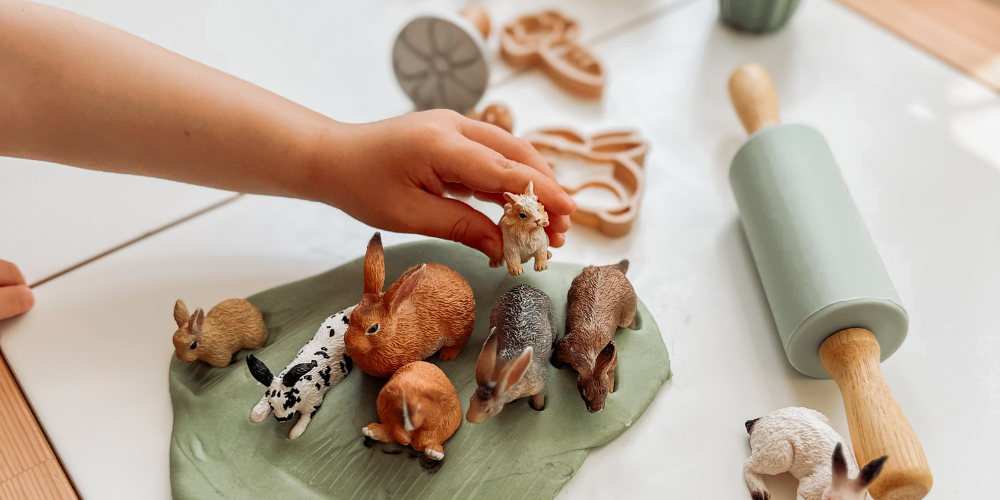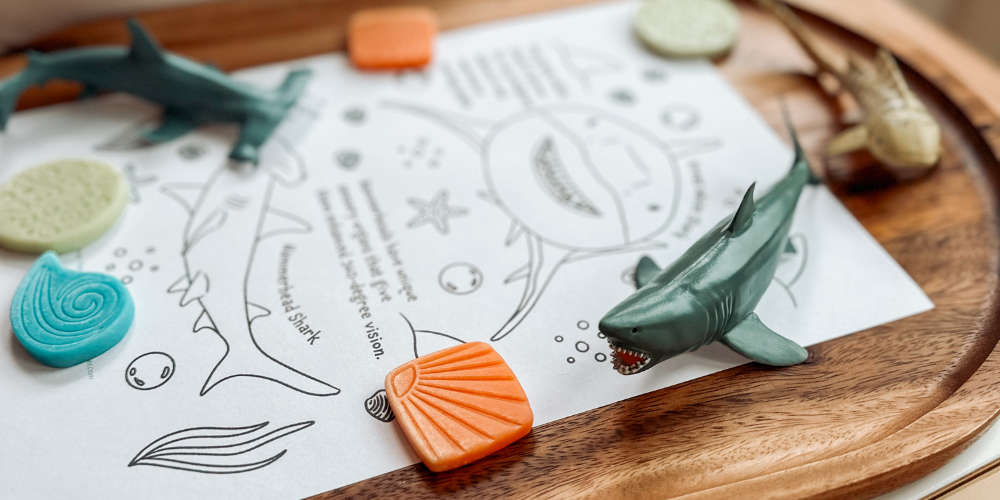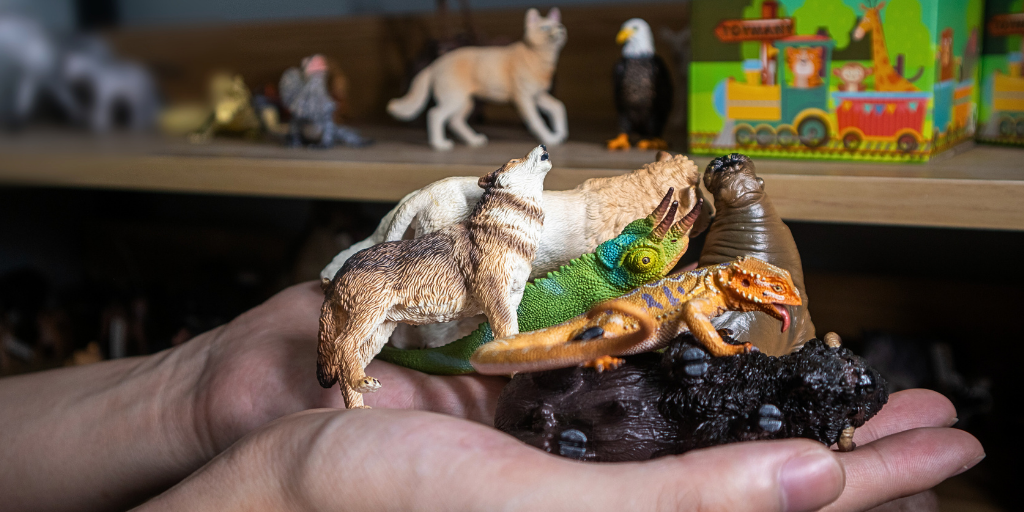تخيل تحويل منزلك إلى فصل دراسي حي حيث تماثيل الحيوانات ليست مجرد ألعاب، بل بوابات للتعلم. باستخدام تماثيل الحيوانات بشكل استراتيجي، يصبح اللعب التعليمي أكثر جذبًا وأغنى بالمعرفة. هذه الألعاب الصغيرة تحمل تأثيرًا كبيرًا، حيث تعزز التطور المعرفي، والتعليم العاطفي والاجتماعي، وتجعل المواضيع مثل العلوم والرياضيات ممتعة وسهلة الوصول.
لماذا استخدام تماثيل الحيوانات لأغراض تعليمية؟
تماثيل الحيوانات هي أدوات ديناميكية تحفز التطور المعرفي من خلال التعلم التفاعلي في التعليم المنزلي. تشجع هذه التماثيل الأطفال على استكشاف وفهم العلاقات المكانية، ممارسة مهارات حل المشكلات، وفهم المفاهيم المعقدة من خلال التفاعل النشط.
علاوة على ذلك، تلعب تماثيل الحيوانات دورًا حيويًا في التعليم العاطفي والاجتماعي. بينما يقوم الأطفال بتقمص الأدوار مع هذه الألعاب، يتعلمون التعبير عن مشاعرهم، والتعاطف مع الآخرين، وتطوير مهارات اجتماعية في بيئة آمنة ومتحكم فيها. يشجع هذا النوع من اللعب ليس فقط على اكتساب المعرفة ولكن أيضًا على تنمية المهارات الشخصية الهامة، مما يساعد العقول الشابة على النمو في الفهم والرحمة.
دمج التماثيل في تعلم المواد
بينما نغوص في هذه الرحلة الرائعة معًا، سأعرض لك كيف يمكن لهذه الألعاب الصغيرة أن تحدث تأثيرًا كبيرًا في التعليم.
استكشاف العلوم: فهم موائل وسلوكيات الحيوانات

توفر تماثيل الحيوانات وسيلة ملموسة لاستكشاف المفاهيم المعقدة مثل النظم البيئية وسلوكيات الحيوانات. على سبيل المثال، يمكن أن يساعد إعداد موطن باستخدام ألعاب تماثيل الحيوانات الزواحف الأطفال على فهم أين وكيف تعيش الحيوانات الزاحفة، ما تأكله، والأدوار التي تلعبها في بيئاتها.
الرياضيات باستخدام التماثيل: العد، التصنيف، والتصنيف

يمكن أن يؤدي دمج التماثيل في دروس الرياضيات إلى تحويل الأرقام المجردة إلى أمثلة ملموسة. يمكن للمتعلمين الصغار استخدام التماثيل لممارسة العد، تصنيف الحجم أو النوع، وحتى تجميعها في فئات، مما يعزز مهاراتهم العددية وقدرتهم على تصنيف وتنظيم المعلومات.
فنون اللغة: سرد القصص وبناء المفردات

تلهم التماثيل بشكل طبيعي سرد القصص، مما يسمح للأطفال بإنشاء قصص تبني المفردات وتحسن مهارات اللغة. تصبح كل تمثال شخصية لها قصتها الخاصة، مما يشجع الأطفال على التعبير عن أنفسهم واستكشاف كلمات وعبارات جديدة في السياق.
الفن والإبداع: اللعب الخيالي

في الفن، يمكن استخدام التماثيل لإثارة الإبداع، حيث تعمل كنماذج للرسم أو مواضيع لسيناريوهات اللعب الخيالي. من خلال هذه الأنشطة، يطور الأطفال تقديرًا أعمق للفن ويشجعون على التعبير عن رؤاهم الفنية الفريدة.
من خلال دمج تماثيل الحيوانات في التعلم اليومي، نفتح عالمًا من الفرص لأطفالنا، مما يجعل التعليم ممتعًا وذا تأثير.
الأنشطة المناسبة للعمر للمستويات التعليمية المختلفة
الأنشطة للأطفال في مرحلة ما قبل المدرسة: التعرف الأساسي والمطابقة
بالنسبة لأصغر مستكشفي الطبيعة، يمكن أن تقدم تماثيل الحيوانات أساسيات مملكة الحيوانات. يمكن للأنشطة البسيطة مثل مطابقة الحيوانات مع أسمائها أو صورها أن تساعد الأطفال الصغار في تطوير مهارات التعرف والمفردات. من الرائع أن نرى وجوههم الصغيرة تضيء عندما يتعرفون بشكل صحيح على قرش المطرقة بونيت هيد أو قرش الليمون!

المشاريع للأطفال في سن المدرسة: إنشاء المواطن وسلاسل الغذاء
مع نمو الأطفال، ينمو أيضًا قدرتهم على الفهم الأكثر تعقيدًا. يمكن للأطفال في سن المدرسة استخدام تماثيل الحيوانات لإنشاء مواطن تفصيلية، مثل الصحاري، الغابات، أو المحيطات، والتعرف على سلاسل الغذاء داخل هذه البيئات. على سبيل المثال، يمكن إعداد شاطئ صغير باستخدام تماثيل السلاحف البحرية. لا يساعد هذا النهج التفاعلي فقط في تثبيت فهمهم لكيفية عمل النظم البيئية، بل يعزز أيضًا الشعور بالمسؤولية تجاه الحفاظ على البيئة.

المفاهيم المتقدمة للأطفال الأكبر سنًا: التنوع البيولوجي وجهود الحفاظ على البيئة
بالنسبة للأطفال الأكبر سنًا، حان الوقت للتعامل مع مفاهيم أكثر تقدمًا. باستخدام التماثيل، يمكنهم دراسة التنوع البيولوجي، والتعرف على أهمية الحفاظ على البيئة، وحتى قيادة مشاريع صغيرة حول كيفية حماية الأنواع المهددة بالانقراض. تساعد هذه الأنشطة في إعدادهم للتفكير النقدي حول قضايا البيئة وتعليمهم قيمة الحفاظ على عالمنا الطبيعي.

مع كل خطوة، تعمل تماثيل الحيوانات كأدوات تعليمية تُحيي تعقيدات الطبيعة. لذا، سواء كنت والدًا، معلمًا، أو متعلمًا فضوليا، تقدم هذه التماثيل فرصًا لا حصر لها للتعليم والمشاركة والاستمتاع.
نصائح للآباء والمعلمين
إعداد ركن تعليمي باستخدام التماثيل
إن إنشاء مساحة مخصصة للتعلم يمكن أن يؤثر بشكل كبير على رحلة الطفل التعليمية. يمكنك ترتيب تماثيل الحيوانات مع الكتب ذات الصلة، الخرائط، وربما حتى بعض العناصر الطبيعية مثل الصخور والنباتات لمحاكاة المواطن المختلفة. هذا الإعداد يدعوهم للاستكشاف والتعلم حتى خلال وقت اللعب الحر.
دمج التماثيل في الأنشطة اليومية للتعلم
يمكن أن يكون دمج هذه التماثيل في الأنشطة اليومية للتعلم ممتعًا وتعليميًا في الوقت ذاته. استخدمها في دروس العلوم لمناقشة سلوك الحيوانات وموائلها أو في الرياضيات للمساعدة في تمارين العد والتصنيف. في فنون اللغة، شجع الأطفال على إنشاء قصص حول التماثيل، مما يساعد في تطوير مهارات السرد والمفردات لديهم.
من خلال دمج هذه التماثيل في جوانب مختلفة من التعلم، يمكنك تقديم تجربة تعليمية ديناميكية تكون مشوقة وتعليمية ولا تُنسى. سواء كنت تعلم مفهوماً معقداً أو تبحث فقط عن طريقة لتنشيط خطط الدروس، يمكن أن تكون تماثيل الحيوانات "مصدرًا أساسيًا" في المنزل!




اترك تعليقًا
تخضع جميع التعليقات للإشراف قبل نشرها.
This site is protected by hCaptcha and the hCaptcha Privacy Policy and Terms of Service apply.